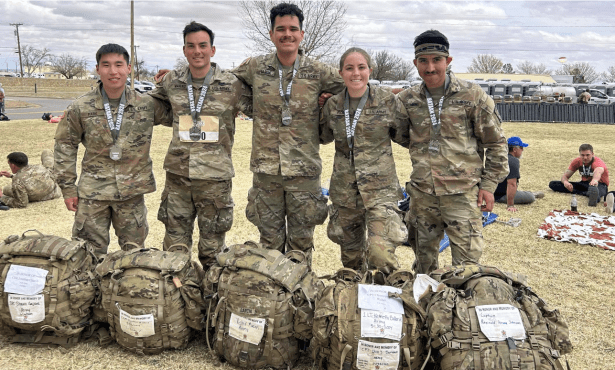Los Prietos Boys Camp Closing: ‘The End of an Era’ in Santa Barbara County?
Youth Orgs Push Back Against Decision to Merge Programs into Santa Maria Juvenile Hall

In 2017, teenager Sammy Chavoya found himself headed down the wrong path, on the wrong side of the law, and eventually stuck in the Santa Barbara County juvenile justice system.
He was sent to Los Prietos Boys Camp, the 17-acre facility deep in the Los Padres National Forest that serves as a “lesser alternative” to the juvenile hall in Santa Maria, where more serious youth offenders are typically housed.
Up at camp, far away from the distractions and temptations of life back in Lompoc, Chavoya was given the opportunity to take a step back and evaluate where he was headed in life. More than that, he was given access to counseling, group therapy, and classes that taught him new skills and empowered him to take control of his own life.
Five years later, he is a student at West Los Angeles City College, studying film production with his mentor Scott Budnick — executive producer of Just Mercy, The Hangover, and Old School — and well on his way to starting his own career in filmmaking and storytelling.
He recently returned from a trip to Boston, where he was part of a roundtable discussion with the Anti-Recidivism Coalition and Boston Celtics. It was a life-changing moment, he said, to travel across the country, visit a juvenile hall in Boston, and speak on his own life experience while sitting right next to Celtics superstar Jaylen Brown.
Chavoya credits much of his turnaround to his time at Los Prietos and the weekly leadership programs led by local nonprofit Freedom 4 Youth at the camp, which he says were the “biggest factors” in his life. But with plans in motion to close the camp and instead move the programs into an underused wing at the Santa Maria juvenile hall, now known as the Susan J. Gionfriddo Juvenile Justice Center, Chavoya and advocates from Freedom 4 Youth are worried that future generations will lose out on a facility that has helped youth in Santa Barbara County since 1945.
“If it closes, it will be the end of an era,” Chavoya said. “I would just give up on Santa Barbara; I could see so much potential being wasted.”
The decision to close the camp is mostly due to declining population in the juvenile justice system, according to Tanja Heitman, chief probation officer of the county’s probation department. Decades ago, the county had three facilities for delinquent youth, with the camp housing 70-80 boys at any given time. Combined with both juvenile halls, there could be more than 200 youth detained in the county system.
The Santa Barbara facility has since closed, and today, the number of detained youth is 29. At Los Prietos, there are currently three boys.
With so few kids, Heitman said it made sense to combine the two facilities, and although the county explored “every option,” it was eventually decided to fold the programming at the camp into a remodeled unit at the juvenile hall. The updates will take place over the next year, during which the Probation Department will hold public meetings on what type of programs can be implemented at the facility.
The plan is to create a new unit that would keep all the staff and resources from the camp, but now at the Santa Maria location, which she said would be more accessible for visitors. It will also allow more of the boys to enroll in the programs typically offered only at the camp.
“What we all love about the camp is that it’s situated in the national forest,” Heitman said. “We can’t re-create that up in Santa Maria, but we can offer similar opportunities.”
In recent years, the juvenile hall — and juvenile justice in general — has undergone reforms to make the system more geared toward rehabilitation than punishment. At the Gionfriddo Center, the cold, cell-block environments have been updated with couches, video games, and workout equipment. Now, one area is called a “Trust Unit,” where doors are unlocked and kids are given space to interact and move as they wish.
Sign up for Indy Today to receive fresh news from Independent.com, in your inbox, every morning.
Even still, some of the advocates with local youth organizations are unconvinced that the hall offers the same holistic freedom and natural solitude of the camp.
“You can’t just put up a couch and call it a Trust Unit,” said Billi Jo Starr, cofounder of Freedom 4 Youth. The organization has been pushing for Probation to consider alternatives to closing the camp, like using the $1.5 million set aside for the Santa Maria juvenile hall remodel to instead make the camp secure and move the 26 kids from the hall to the camp.
Since the juvenile hall’s operating budget is almost double that of the camp, Starr said, the move would be cheaper in the long run.
“If we were really talking about fiscal responsibility, why would we not?” she said.
Heitman said it would be difficult to house kids from juvenile at Los Prietos because it’s technically not secure there and putting up the fences needed to secure the camp would impede wildlife. Overall, the location is not meant for the infrastructure of a juvenile center, she said.
Jordan Waller is part of Freedom 4 Youth’s Lived Experience Executive Division and has spent time in both facilities.
“Los Prietos is a way better experience than the hall,” he said. “I learned a lot there.”
At the camp, Waller said he was enrolled in classes, one-on-one therapy, and group sessions and even joined a culinary program, where he eventually found a love for cooking. He now caters many of the organization’s events.
“It was a better life and experience. You don’t get that when you’re locked down,” he said.
In the juvenile hall, he said, youth are conditioned for incarceration. There’s a toxic environment that lends itself to fights and leads to more mental-health problems. “You’re not gonna be rehabilitated there,” he said.
“You just feel like an animal. You don’t learn anything except ‘I’m bad,’” Chavoya said. “I’m not bad. What I did was bad.”
There is also the feeling that the youth and their families were not involved in the decision-making process. The decision was somewhat buried in the Probation Department’s budget, and many community members only found out about plans after the choice had been made.
Freedom 4 Youth’s director of development, Dylan Griffith, said that there were several viable alternatives to closing the camp. One of those options, he said, would be to expand the camp to accept youth from Ventura and San Luis Obispo counties, similar to the way the camp operated when it first opened.
Another would be a change in state legislation that would allow young adult males ages 18 and 19 to qualify to serve their time at the camp, though Heitman said that similar legislation has stalled in the past.
In an independent survey of individuals who have spent time at the camp or the hall, Freedom 4 Youth found that 100 percent of participants agreed that the living conditions at Los Prietos “provided them with a healthy environment where their mental and physical needs were cared for,” compared to 18.1 percent at the juvenile hall. More than 59 percent said they would prefer to close the hall over the camp, while zero percent said they would choose to close the camp.
Heitman says she hopes to continue to work with the community and hold public meetings where everybody can provide input on what kind of programs they would like to see. She also encourages people to understand that both the camp and the hall have changed dramatically over the years.
“A lot of people have this vision of the camp 10 years ago,” she said. A lot of the programs that were once flourishing — like the culinary, auto mechanics, and computer technology programs — have faded away without the population to enroll in them.
The new challenges forced the department to “reenvision” what can be done with the resources available now, she said, and although the juvenile justice system is changing, she wants the community to stay involved with the process.
“We all have the same goals. We all want the best for our kids,” Heitman said. “We want to give them educational and vocational options that excite them, so that when they return to the community, they come back with the best opportunities.”
Support the Santa Barbara Independent through a long-term or a single contribution.



